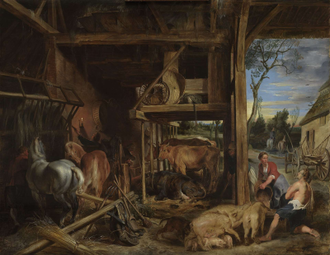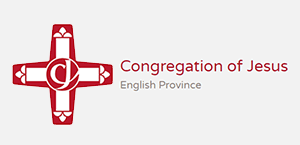Gospel in Art: Laetare Sunday: the Prodigal Son

The Prodigal Son, by Peter Paul Rubens, 1618, Oil on canvas © Royal Museum of Fine Arts Antwerp
Source: Christian Art
Gospel of 30 March 2025
Luke 15:1-3, 11-32
At that time: The tax collectors and sinners were all drawing near to hear Jesus. And the Pharisees and the scribes grumbled, saying, 'This man receives sinners and eats with them.'
So he told them this parable: 'There was a man who had two sons. And the younger of them said to his father, "Father, give me the share of property that is coming to me." And he divided his property between them. Not many days later, the younger son gathered all he had and took a journey into a far country, and there he squandered his property in reckless living. And when he had spent everything, a severe famine arose in that country, and he began to be in need. So he went and hired himself out to one of the citizens of that country, who sent him into his fields to feed pigs. And he was longing to be fed with the pods that the pigs ate, and no one gave him anything.
'But when he came to himself, he said, "How many of my father's hired servants have more than enough bread, but I perish here with hunger! I will arise and go to my father, and I will say to him, 'Father, I have sinned against heaven and before you. I am no longer worthy to be called your son. Treat me as one of your hired servants.' "
'And he arose and came to his father. But while he was still a long way off, his father saw him and felt compassion, and ran and embraced him and kissed him. And the son said to him, "Father, I have sinned against heaven and before you. I am no longer worthy to be called your son." But the father said to his servants, "Bring quickly the best robe, and put it on him, and put a ring on his hand, and shoes on his feet. And bring the fattened calf and kill it, and let us eat and celebrate. For this my son was dead, and is alive again; he was lost, and is found." And they began to celebrate.
'Now his older son was in the field, and as he came and drew near to the house, he heard music and dancing. And he called one of the servants and asked what these things meant. And he said to him, "Your brother has come, and your father has killed the fattened calf, because he has received him back safe and sound." But he was angry and refused to go in. His father came out and entreated him, but he answered his father, "Look, these many years I have served you, and I never disobeyed your command, yet you never gave me a young goat, that I might celebrate with my friends. But when this son of yours came, who has devoured your property with prostitutes, you killed the fattened calf for him!" And he said to him, "Son, you are always with me, and all that is mine is yours. It was fitting to celebrate and be glad, for this your brother was dead, and is alive; he was lost, and is found." '
Reflection on the Painting
In the world we live in, there is often an assumption that for one person to succeed, another must fail. This idea is clearly evident in competitive areas like sports, where if one team wins, the other inevitably loses. However, this mentality extends beyond the playing field into many aspects of life. Within families, for example, if one child receives a gift, others may feel overlooked, creating tension. Parents sometimes try to ease this by giving small tokens to the other children when a sibling celebrates a birthday. Adults are not immune to this dynamic either. In workplaces or organisations, when one person is publicly recognised or honoured, others may feel undervalued, even if no slight was intended. In political settings, particularly in efforts to build peace and unity, it can be challenging to overcome the belief that a gain for one side automatically means a loss for the other. This 'winners and losers' mindset is simply deeply ingrained in human nature.
Jesus offers a different perspective, portraying a father who shows no favouritism but instead loves all his children equally and unconditionally. In his vision, there are no winners and losers-only beloved sons and daughters, each embraced by the same tender mercy. The father in the parable cherishes both the prodigal child and the dutiful one, extending his love freely without condition. In presenting this image, Jesus not only describes the nature of a compassionate parent but also reveals something essential about himself and his Father. Divine love does not discriminate; it is given lavishly, even in ways that may seem excessive by human standards! On this Laetare Sunday, we are reminded to rejoice in this limitless love-a love that does not measure, compare, or exclude but simply embraces all.
The Prodigal Son showcases Pieter Paul Rubens' signature Baroque style, marked by dramatic movement, rich colour, and emotional intensity. To the right of the composition, we see the Prodigal Son, dressed in ragged, tattered clothing. His bare chest, legs and feet suggest his complete loss of status and dignity. His posture is one of despair, as he crouches or kneels on the ground, seemingly pleading for help to the owner's daughter of the farm where he is working. But she can't help him. His hands are extended, in supplication or resignation, as he realises the depths to which he has fallen. His gaunt face reflects his suffering, making it clear that this is the moment before his decision to return home. Enough is enough, he is at the point of going back to his father. The pigs and animals are all painted in rich, fleshy tones, looking better and more healthy than the Prodigal Son.
This is an interesting painting, as usually the father is portrayed in paintings depicting today's parable. The absence of the father suggests that the painting is meant to capture not reconciliation, but the moment before: transformation! Thus the painting emphasises the importance of repentance just before the turning point in the son's journey.
LINKS
Gospel in Art: https://christian.art/
Today's Reflection: https://christian.art/daily-gospel-reading/luke-15-1-3-11-32-2025-2/ (with audio)


















